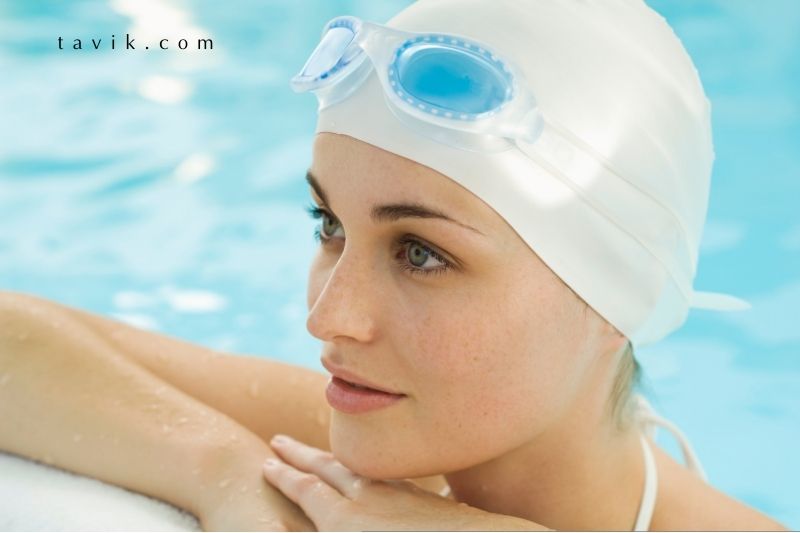Swimming goggles are a must-have for any swimmer, whether you're a beginner or a pro. They help keep your eyes safe from the chlorine in the water and the sun's harmful UV rays. They also help you see where you're going underwater. But with so many different types and styles of swimming goggles on the market, it can be hard to know which ones are right for you. Here's a quick guide to the different types of swimming goggles and How To Use Swimming Goggles.
How To Use Swimming Goggles?
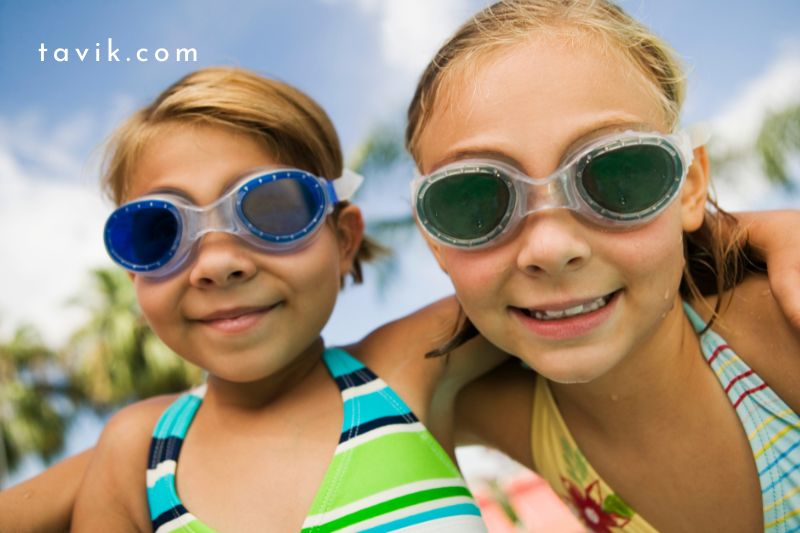
Method 1: Putting on and Taking off Swim Goggles
Grip the goggles by the edges of the eyecups
Hold the goggles so that the inside of the lenses are facing towards you. Place your thumbs at the bottom of the eyecups, then wrap your pointer fingers around the tops of the frames. Your right thumb should be resting on the right cup, with your left thumb on the left cup.
- Flip the backstrap over to the front side of the goggles to keep it out of the way while you put them on.
- Alternatively, you can start with the backstrap around your neck and the goggles dangling in front of you.
Press the goggles against your eyes.
Bring the goggles up to your face, guiding the eyecups over your eyes. Press your fingers gently into the edges of the frames. You should feel a slight suction as they form a seal on the skin around your eyes.
- Only the soft rubber around the inside of the eyecups should come into contact with your face.
- Make sure the eyecups don't pinch or tug at your skin. If they do, you may need to remove and reposition them until they feel comfortable.
- Avoid touching the lenses themselves. Doing so could leave behind streaks and obstruct your vision underwater.
Guide the backstrap up and over your head.
Keeping the goggles pressed to your eyes with one hand, use your other hand to position the strap until it rests against the back of your head at around eye level. The belt and the eyepieces should form a straight horizontal line when viewed from the side.
- If the strap doesn't feel comfortable where it is, slide it up rather than down. The lower it is, the more likely your goggles will be to slip while you're swimming.
Adjust the backstrap to get a comfortable and secure fit.
Pull the loose end of the rubber strap through the buckle slot on the side of the frame to tighten your goggles. If you want to loosen them instead, lift up on the buckle lever and pull the strap out to put a little slack in it. Your goggles should be snug but not tight.
- Before diving in, double-check that the goggles fit securely around your eye sockets and that you can see clearly out of both lenses.
Pull the backstrap over your head from the back to remove the goggles.
When you're ready to take off your goggles, reverse the motion you used to put them on. Reach behind your ears and slide your thumbs underneath the sides of the backstrap, then lift it over your crown until the goggles come free.
- Don't try to remove your goggles by pulling on the eyecups. If you're not careful, they could snap back and hit you in the face!
Method 2: Testing Goggles for Fit
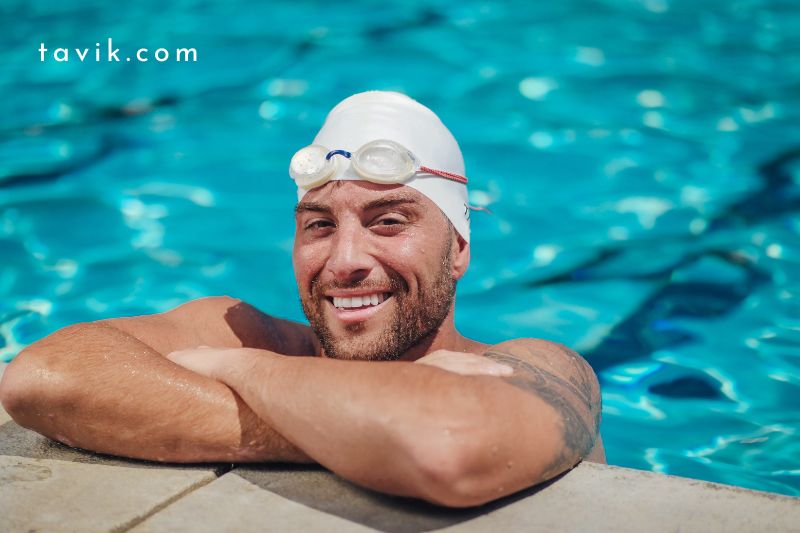
Select a pair of goggles that fits comfortably around your eyes.
When shopping for a new pair of goggles, try on a few different teams to compare the lenses' shapes and the eyecups' feel. The right pair of goggles should conform to your face to the point where they're hardly noticeable. If the eyepieces pinch, pull or restrict your field of vision, it's best to go with another pair.
- For example, if you have rounded eye sockets, you'll probably be most comfortable in goggles with smooth, rounded eyepieces. If your eyes are more almond-shaped, look for a pair with contoured rubber around the eyecups.
- Taking the time to pick out goggles that fit correctly can mean the difference between swimming freely and being in constant discomfort.
Press the eyecups to your face to test out the suction.
Put the eyepieces around your eyes, then apply gentle pressure to the edges. If the goggles are a good fit, they should stick to your skin for a few seconds before popping off.
- You don't need to actually slip the backstrap over your head. At this point, you're just testing how well the eyecups fit on their own.
- Goggles that fall off immediately are most likely the wrong shape for your face.
- If only one of the eyecups stays put, it doesn't necessarily mean that the goggles are a poor fit. Try on a couple of other pairs and note the differences between them before making a decision.
Pull-on the backstrap to get a feel for how the goggles wear.
Once you're satisfied with how the eyepieces fit, finish putting the goggles on the way you usually would. Guide the backstrap over your head to a level with the eyecups. With minimal adjusting, it should fit snugly without squeezing.
- If you get a headache or experience cloudy vision after wearing the goggles for a couple of minutes, pass them up and look for a more suitable pair.
- The rubber backstrap may pull on your hair during your test fitting. This can be uncomfortable, but it doesn't necessarily mean a lousy pair of goggles. You shouldn't have the same problem once you're in the pool or wearing a swim cap.
Adjust the nose strap by changing the distance between the eyepieces.
Some more expensive types of swim goggles feature adjustable nose straps. These can be tightened by unclipping the strap where it meets the eyepiece and reattaching it for a better fit around the bridge of the nose. To loosen the nose strap instead, move the eyepieces further apart.
- Like the eyepieces, the nose strap must fit comfortably if you wear your goggles for an extended period.
- Not all goggles have adjustable nose straps. As long as the pair you're trying on fits properly around the eyes, adjustable straps aren't necessary.
Look for goggles with deep eyepieces if your eyelashes brush the lenses.
Brushing eyelashes can be a significant distraction when trying to concentrate on swimming. To ensure you don't have this problem, try blinking a few times once you've got the goggles on your face. If you feel your lashes scraping the backside of the lenses, consider buying a pair that offers more space.
- Goggles with roomier eyepieces sit further away from the eyes, giving long eyelashes more freedom to move while blinking.
Method 3: Finding the Right Pair of Goggles for You
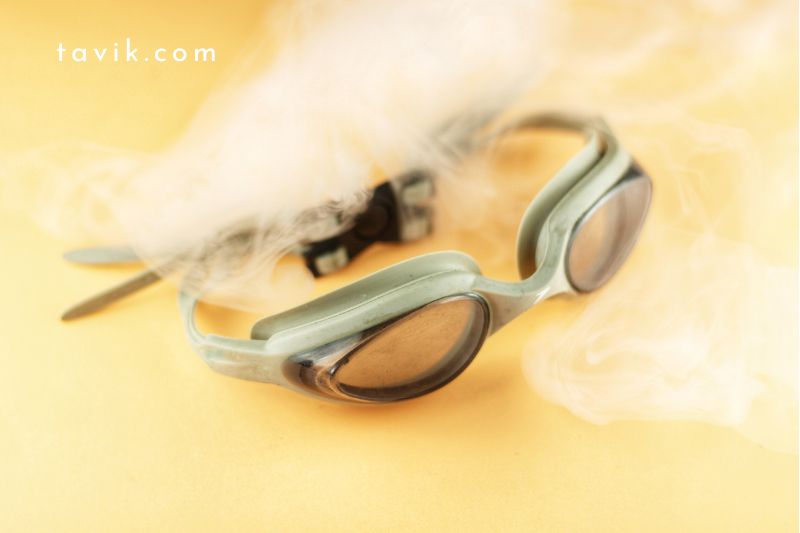
Pick up some Swedish goggles for affordable comfort.
Swedish goggles are an older style of water eyewear that is still popular with many swimmers. They feature eye cups molded out of hard plastic, with lenses that offer UV protection for outdoor swimming. Most pairs also have an adjustable nose strap that joins the eyecups together.
- A 2-pack of Swedish goggles only costs about $15, making them a more economical option if you're not set on using top-of-the-line equipment.
- Swedish goggles have to be assembled before their first use. For this reason, they may be a little too complicated for small children.
- One downside of Swedish goggles is that the hard plastic used in their construction makes them slightly less comfortable for prolonged wear.
Shell out for racing goggles for optimum comfort and performance.
Racing goggles are made from lightweight, hydrodynamic materials and offer a perfect watertight seal every time. This emphasis on comfort will allow you to focus solely on swimming. As an added bonus, they come in an array of shapes and sizes, so you'll always be able to find a pair to fit your face.
- A good pair of racing goggles can run up to USD 50, but remember that when it comes to specialty sports equipment, you get what you pay for.
- Since they're smaller than ordinary, racing goggles may put more pressure on the eye sockets when used for long swimming sessions.
Use tinted lenses to cut down on glare.
Goggles with darkened lenses are the swimmer's equivalent of sunglasses. Since they typically offer UV protection and an anti-fog coating, they're helpful for blocking out sunlight on bright days. Tinted lenses may be a wise choice if you tend to do most of your swimming outdoors in the morning or afternoon.
- You should be able to buy goggles with tinted lenses anywhere that swimming equipment and accessories are sold.
- Like sunglasses, darkened goggles aren't meant for indoor use. Wearing them inside may make it harder to see your mark, the lane dividers, or other swimmers.
Try out a pair with colored lenses to improve visibility indoors.
Colored lenses let in varying amounts of light, making them well-suited for a wide range of conditions. Amber and yellow lenses, for example, are effective for making pools appear brighter underwater. Similarly, blue lenses provide optimum clarity for open water swimming.
- Swim goggle lenses come in a variety of different colors. The color that works best for you will depend mainly on the depth, color, and water chemistry of the pool you swim in most of yours.
- When swimming in a poorly-lit environment, it's best to stick with ordinary clear lenses to avoid any additional distortion that could interfere with your vision.
Order prescription goggles if you have particular vision requirements.
Visit your eye care specialist to have a pair made to your exact specifications. Prescription goggles use the same corrective lenses like glasses or contacts, so you can enjoy crystal clear vision underwater and save room in your gear bag.
- You may also be able to find premade versions in common prescriptions at some swim shops.
- As a general rule, you shouldn't wear contact lenses in the water due to the risk of bacterial contamination. If you cannot track down prescription goggles, however, you can put in some disposable contacts and throw them away at the end of your session.
How to Stop My Swim Goggles From Leaking?
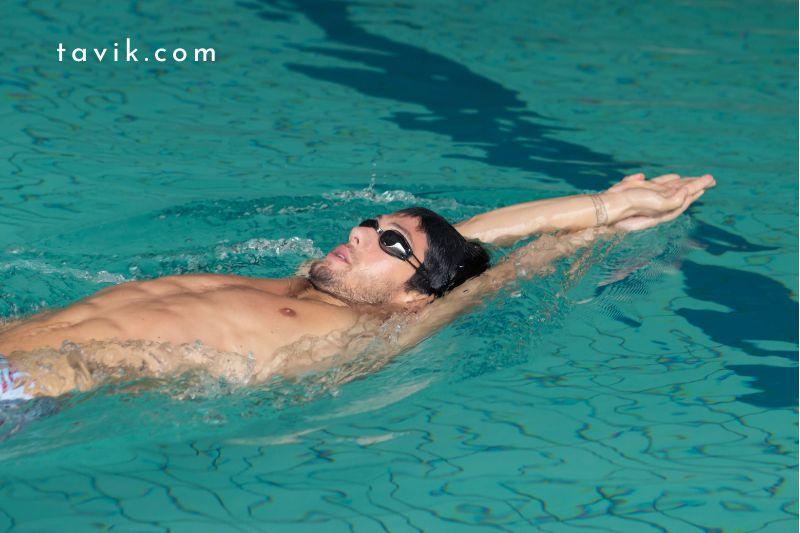 Even if your eyesight is satisfactory on land, don't be shocked if your vision is fuzzy underwater if you don't use goggles. Goggles act as a protective shell over your eye's lens, allowing you to see clearly and crisply when swimming. You may suffer eye discomfort and vision distortion if your goggles suddenly leak while swimming. Rather than putting up with the pain and emptying the lenses every few minutes, take steps to prevent leaking.
Even if your eyesight is satisfactory on land, don't be shocked if your vision is fuzzy underwater if you don't use goggles. Goggles act as a protective shell over your eye's lens, allowing you to see clearly and crisply when swimming. You may suffer eye discomfort and vision distortion if your goggles suddenly leak while swimming. Rather than putting up with the pain and emptying the lenses every few minutes, take steps to prevent leaking.
Step 1
Examine your goggles for flaws such as twisted or kinked frames. Place them in hot water for five minutes if you see anything unusual. Allow them to cool for a minute before pressing them into your face to remold them into a form that suits your face better.
Step 2
Keep your goggles in a sturdy case to keep them from becoming twisted or distorted. Goggles that have been disfigured often become leaky goggles.
Step 3
Adjust the nosepiece and strap on your head, so there are no gaps between the seal and your eyes. Moving the eyepieces away from your face if you tighten your head belt too much may create additional leaking.
Step 4
Before swimming, push the goggles firmly against your face to seal them to your eyes. This will aid in the prevention of leaks around the edges.
Step 5
Maintain a neutral look on your face. While swimming with goggles, making faces or squinting your eyes may cause your eyes to crumple at the corners, the seal on your goggles to fail, and water to pour in. This may need some deliberate effort, particularly if you begin to tire throughout your exercise and create unintentional expressions as you push yourself to work hard.
Step 6
If your goggles show signs of wear, it's time to replace them. Even the most fabulous pair of goggles may lose their seal over time.
Tip
Clean your goggles after each use to remove any chemical residue that might cause the goggles to break down faster. Using toothpaste is the best way to clean goggles. Ask the pool store cashier for assistance selecting a set of goggles that will suit your face. Expect to replace goggles for youngsters frequently if you purchase them for them. Because children's bodies develop and change, a pair of goggles that functioned six months ago may no longer fit.
5 Tips for Getting Started with FORM Goggles
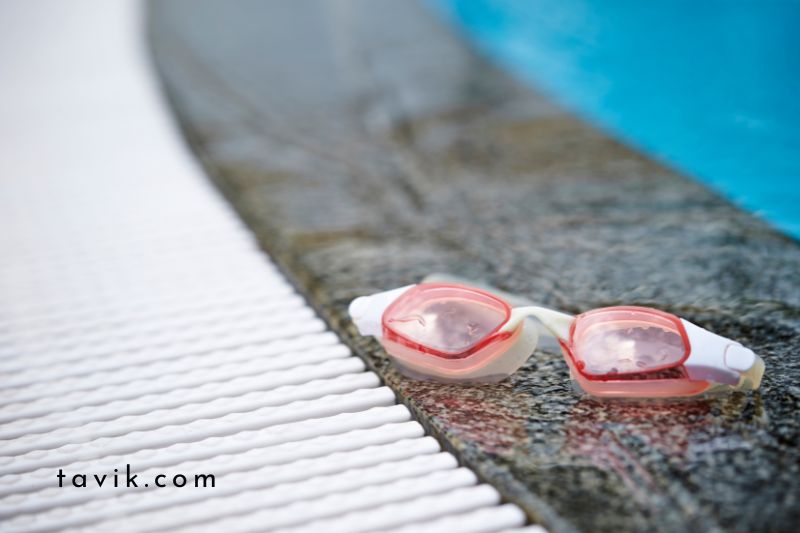 Here's a simple checklist to make sure your first swim is a success:
Here's a simple checklist to make sure your first swim is a success:
1) Discover the best match for you
You've followed all the fitting instructions, but there's no way of knowing whether you've had a watertight fit until you go in. We've all been there with new goggles, thinking they'll fit perfectly in our living room or kitchen, only to go into the pool and discover they're leaking. Bring your nasal bridge card poolside for your first few swims so you can simply switch them out until you find the ideal fit. Check out this video for tips on getting the perfect fit:
2) Knowing what to expect
The FORM goggles are not your typical set of goggles because of the built-in display. It might be a little daunting the first time you wear the goggles. We advocate utilizing them in a non-key exercise or as a warm-up or warm-down for your first swim. Instead of staring at the picture, try concentrating on seeing beyond it. Our revolutionary waveguide technology projects the display away from the user. At the same time, our goggles are submerged in water, allowing you to see through it without blocking your line of sight.
3) When to utilize the pause button
Swimmers are divided into two groups: those who may wear their goggles for the whole exercise and those who must remove them between sets. Nothing compares to pulling your goggles off after a particularly long or complex set (it's simply easier to catch your breath!) for those of you on the goggles-off side. This is an ideal opportunity to utilize the stop button to guarantee your goggles don't misinterpret this action as swimming. Simply click the FRONT button before removing your goggles to ensure no erroneous swimming laps are registered.
4) Rinse your goggles after swimming
Rinsing your goggles in clean, running water will assist in guaranteeing their lifespan. This can help you get the most out of your goggles in future swims by removing any potentially harmful elements, such as chlorinated water. To avoid lens damage in your luggage, we recommend putting your goggles in the included hard-shell case.
5) Don't Forget to Sync
Now that you've nailed your swim exercise, what's next? You'll want to sync your goggles to your FORM Swim App - launch the FORM app on your mobile device while the goggles are still on, and the goggles will instantly sync. You may then evaluate your statistics and submit your swim to third-party training applications like Strava, TrainingPeaks, Final Surge, and Today's Plan.
Bonus tip
Your FORM goggles contain an anti-fog film on the inside of the lens, and it's crucial not to contact the inside of your goggles with your finger to safeguard this film. Fogging may be resolved by dipping the inside of your goggles into the pool and allowing the water to drain out. This should bring the temperature back to normal and eliminate any fogging concerns.
FAQs
1. How To Adjust The Nose Pieces On Speedo Goggles?
To adjust the nasal bridge on your goggles, grip the nose bridge in one hand and place your thumb on the lens with the other. Pull the nose bridge higher while pulling the lens downwards with the other hand. Please remember that the first time you do it, you will need to use some effort. Read also: How to Swim Without Goggles?
2. Should I Wet My Goggles Before Swimming?
When you're dry, and your goggles are dry – that is, before you get into the water, before you get wet, and before your goggles get wet - spit on the inside of the lenses (only saliva, if you don't mind) and wash it around the inside of the lens.
3. Should I Wear Goggles While Swimming?
Wearing goggles protects against chlorinated water and ocean saltwater, which is one of the most evident advantages. It's no secret that when chlorine comes into contact with the eyes, it may cause a lot of stinging.
Conclusion
After reading this article, you will know the best ways to use swimming goggles. Whether a beginner or an experienced swimmer, you will find these tips helpful. Swimming goggles are a great way to improve your swimming experience and protect your eyes from the chlorine in the pool. Thank you for reading!
![How To Put On A Swim Cap: Best Ways To Keep It Secure [2022]](https://tavik.com/wp-content/uploads/2022/06/Types-Of-Swim-Caps.jpg)
